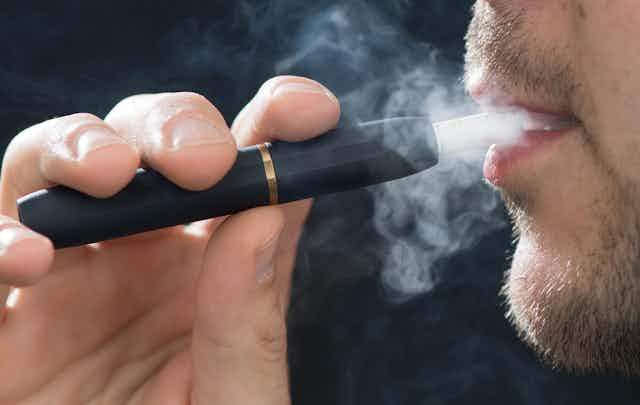Heated tobacco products are designed to heat tobacco without burning it or producing smoke. The popularity of these products soared in Japan after the release of an electronic device called IQOS in 2016. Heated tobacco products are now available in many countries, but questions remained about their effect on cigarette smoking and health, so we set out to review the evidence.
Our new review covers data from 11 studies with over 2,600 people. The headline finding is that people who switched from cigarettes to heated tobacco had lower levels of exposure to harmful chemicals than those who kept smoking, but higher levels of these toxins than those who stopped using tobacco altogether.
This lower exposure was found across a number of harmful substances linked to cancers, heart disease and respiratory problems. This means it is possible that switching from cigarettes to heated tobacco could reduce the odds of developing these diseases, but we don’t have enough data yet to be sure. The studies were all of short duration, and it typically takes a while for people to develop tobacco-related diseases.
That said, the evidence so far is consistent with how uniquely dangerous smoking is. We know that most of the harmful effects of cigarettes — which kill half of all regular smokers — come from inhaling toxic chemicals made by burning tobacco. As heated tobacco products are designed to avoid burning tobacco, we’d expect them to pose a lower risk.
Heated tobacco products could benefit public health if they reduce risk and help people stop smoking normal cigarettes, without attracting people who would otherwise avoid tobacco entirely.
We didn’t find any studies looking at whether giving smokers heated tobacco products helped them stop smoking. But we found two Japanese studies looking at how cigarette sales changed after IQOS entered the market. Both found that falls in cigarette sales sped up after the IQOS launch, suggesting that heated tobacco products might replace rather than complement cigarettes.
On the other hand, it is possible that sales of cigarettes fell because most people cut down without stopping altogether. The greatest improvements in health come from stopping smoking altogether rather than smoking fewer cigarettes.
How they compare with e-cigarettes
E-cigarettes, or vapes, are another group of nicotine products that have become very popular in recent years. Heated tobacco products heat tobacco leaf, whereas e-cigarettes heat a liquid, typically containing nicotine. There are large differences in the science and regulation of these products. E-cigarettes have been on the market for longer than heated tobacco, so we have more evidence about their benefits and harms.
Unlike heated tobacco, e-cigarettes have been shown to help people stop smoking normal cigarettes. In the not-too-distant future, the UK may even offer e-cigarettes to those who wish to quit smoking, as long as the products pass the necessary regulatory hurdles.
Yet some countries, including Japan, have imposed restrictions that have essentially banned the sale of nicotine e-cigarettes, while heated tobacco products remain widely available. This may explain why heated tobacco has taken off in Japan; it’s the only potentially lower-risk alternative to cigarettes available. Heated tobacco use remains rare in countries like the UK and US, where the e-cigarette market was already well-established by the time IQOS launched.
The heated tobacco market is dominated by products from the cigarette industry, which has historically acted to distort science into the harm of cigarettes. Conversely, many e-cigarette manufacturers are unaffiliated with cigarette companies. All safety studies in our review of heated tobacco were conducted by cigarette manufacturers, whereas there are many independent studies of e-cigarettes.
The search for a less harmful cigarette
Tobacco companies have claimed to be searching for decades for a less harmful cigarette. Some attempts, including adding ventilation holes to cigarette filters, have caused more harm.
The e-cigarette was the first non-medical nicotine alternative to cigarettes that appealed widely to smokers around the globe. But e-cigarettes don’t contain tobacco and many manufacturers are unconnected to cigarette companies. Many tobacco companies instead focused on developing heated tobacco devices, a market over which they could maintain greater control through patents.

In 2014, with the introduction of IQOS to test markets by Philip Morris International, sales increased quickly in Japan and South Korea, and other tobacco companies introduced their own electronic heated tobacco devices. Some of the most popular today are glo by British American Tobacco and Ploom by Japan Tobacco International.
Much of the research into the safety of heated tobacco comes from Philip Morris International, which applied for IQOS to be sold as a “reduced exposure” and “reduced risk” tobacco product in the US. In 2019, the US allowed IQOS to be marketed as a reduced exposure product. Their review concluded that “switching completely from conventional cigarettes to the IQOS system significantly reduces your body’s exposure to harmful or potentially harmful chemicals”.
The reduced risk application failed, because “the evidence is not sufficient to demonstrate substantiation of either of the claims about the reduced risk of tobacco-related disease or harm”. We need more evidence to be sure about how using heated tobacco affects people’s health.

